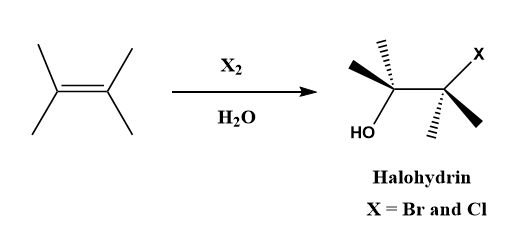
In a reaction

Where, M = Molecules, R = Reagent.
M and R are
(a) \[C{H_3}C{H_2}Cl\] and \[NaOH\]
(b) \[C{H_2}Cl - C{H_2}OH\] and aq. \[NaHC{O_3}\]
(c) \[C{H_3}C{H_2}OH\] and \[HCl\]
(d) \[C{H_2} = C{H_2}\] and heat
Answer
219.9k+ views
Hint: The halohydrin functional group containing a halogen and a hydroxyl group, which are connected to the adjacent carbon atoms. For example: 2-chloroethanol, 3-chloropropane-1,2-diol, etc. Bromohydrin and chlorohydrin are also examples of halohydrin.

Complete Step by Step Answer:
The addition of hypohalous acids (\[HOX\], \[X = Br,Cl\]) to the alkene is an example of an additional reaction. In the given question, we have to determine the molecule (M) and Reagent (R).
As we know that when a molecule of hypohalous acids (\[HOX\], \[X = Br,Cl\]) is added to the double bond of an alkene, the formation of \[C{H_2}Cl - C{H_2}OH\] i.e., formation of M is occurred.
\[C{H_2} = C{H_2} + HOCl \to C{H_2}Cl - C{H_2}OH\]
After that molecule, M undergoes hydrolysis with aqueous sodium bicarbonate (\[NaHC{O_3}\]) OR with reagent R to hydrolyze the \[C - Cl\] bond and form the ethylene glycol (\[C{H_2}OH - C{H_2}OH\]).
\[\begin{array}{l}C{H_2}Cl - C{H_2}OH + aq.NaHC{O_3} \to C{H_2}OH - C{H_2}OH\\\end{array}\]
Like the electrophilic addition reaction of an alkene with bromine, the formation of halohydrin also involves the electrophilic addition reaction, in which anti-addition of chlorine and hydroxyl functional groups occurs with the formation of trans products.
In the question, options (a), (c), and (d) will be the incorrect option because the structure of M is \[C{H_2}Cl - C{H_2}OH\]and reagent R is \[NaHC{O_3}\].
Therefore, we can conclude that option (b) will be the correct answer.
Note: The halohydrins are not formed by the direct addition of hypohalous acid (\[HOX\]), instead the alkene reacts with bromine (\[B{r_2}\]) or chlorine (\[C{l_2}\]) in the presence of water(\[{H_2}O\]). Sodium bicarbonate (\[NaHC{O_3}\]) is also known as baking soda.

Complete Step by Step Answer:
The addition of hypohalous acids (\[HOX\], \[X = Br,Cl\]) to the alkene is an example of an additional reaction. In the given question, we have to determine the molecule (M) and Reagent (R).
As we know that when a molecule of hypohalous acids (\[HOX\], \[X = Br,Cl\]) is added to the double bond of an alkene, the formation of \[C{H_2}Cl - C{H_2}OH\] i.e., formation of M is occurred.
\[C{H_2} = C{H_2} + HOCl \to C{H_2}Cl - C{H_2}OH\]
After that molecule, M undergoes hydrolysis with aqueous sodium bicarbonate (\[NaHC{O_3}\]) OR with reagent R to hydrolyze the \[C - Cl\] bond and form the ethylene glycol (\[C{H_2}OH - C{H_2}OH\]).
\[\begin{array}{l}C{H_2}Cl - C{H_2}OH + aq.NaHC{O_3} \to C{H_2}OH - C{H_2}OH\\\end{array}\]
Like the electrophilic addition reaction of an alkene with bromine, the formation of halohydrin also involves the electrophilic addition reaction, in which anti-addition of chlorine and hydroxyl functional groups occurs with the formation of trans products.
In the question, options (a), (c), and (d) will be the incorrect option because the structure of M is \[C{H_2}Cl - C{H_2}OH\]and reagent R is \[NaHC{O_3}\].
Therefore, we can conclude that option (b) will be the correct answer.
Note: The halohydrins are not formed by the direct addition of hypohalous acid (\[HOX\]), instead the alkene reacts with bromine (\[B{r_2}\]) or chlorine (\[C{l_2}\]) in the presence of water(\[{H_2}O\]). Sodium bicarbonate (\[NaHC{O_3}\]) is also known as baking soda.
Recently Updated Pages
Electricity and Magnetism Explained: Key Concepts & Applications

JEE Energetics Important Concepts and Tips for Exam Preparation

JEE Isolation, Preparation and Properties of Non-metals Important Concepts and Tips for Exam Preparation

JEE Main 2021 July 25 Shift 1 Question Paper with Answer Key

JEE Main 2021 July 22 Shift 2 Question Paper with Answer Key

States of Matter Chapter For JEE Main Chemistry

Trending doubts
JEE Main 2026: Application Form Open, Exam Dates, Syllabus, Eligibility & Question Papers

Derivation of Equation of Trajectory Explained for Students

Hybridisation in Chemistry – Concept, Types & Applications

Understanding the Angle of Deviation in a Prism

How to Convert a Galvanometer into an Ammeter or Voltmeter

Understanding Centrifugal Force in Physics

Other Pages
Solutions Class 12 Chemistry Chapter 1 CBSE Notes - 2025-26

NCERT Solutions For Class 12 Chemistry Chapter 1 Solutions - 2025-26

The D and F Block Elements Class 12 Chemistry Chapter 4 CBSE Notes - 2025-26

NCERT Solutions for Class 12 Chemistry Chapter Chapter 7 Alcohol Phenol and Ether

NCERT Solutions ForClass 12 Chemistry Chapter Chapter 8 Aldehydes Ketones And Carboxylic Acids

JEE Advanced Marks vs Ranks 2025: Understanding Category-wise Qualifying Marks and Previous Year Cut-offs




